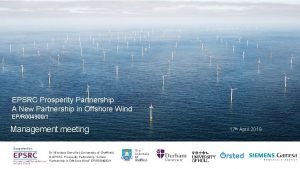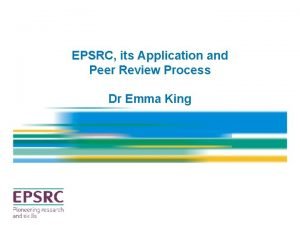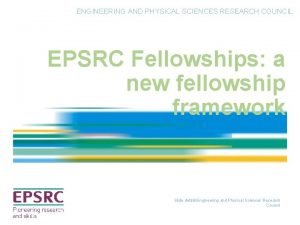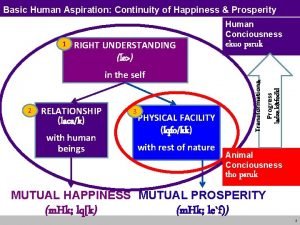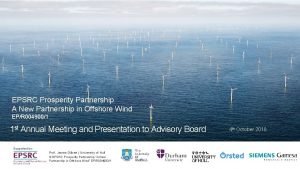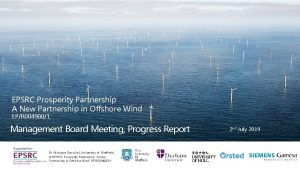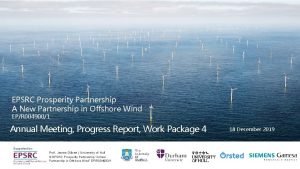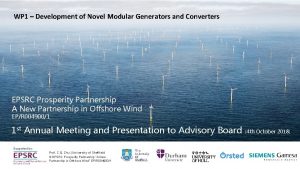EPSRC Prosperity Partnership A New Partnership in Offshore








- Slides: 8

EPSRC Prosperity Partnership A New Partnership in Offshore Wind EP/R 004900/1 Management meeting Supported by: Dr Nikolaos Dervilis | University of Sheffield © EPSRC Prosperity Partnership “A New Partnership in Offshore Wind” EP/R 004900/1 17 th April 2019

2 2. 1. Image analysis and methodologies for determining the mechanical integrity of wind turbine blades. Ph. D Student Jack Barker To develop novel new image analysis techniques. The aim will be to use this to develop new techniques for the detection of damage and surface degradation of wind turbine blades gathered from inspection vehicles or from remote locations (distances of order 100 m from the structures under inspection). The potential for using 3 D imaging techniques capable of detecting faults in the sub surface structure to depths of several millimetres will also be investigated in the study. Supported by: Author | Institution © EPSRC Prosperity Partnership “A New Partnership in Offshore” Wind EP/R 004900/1 Supervisor(s) DU/Orsted Industrial Impact New image analysis techniques available for detecting damage and surface degradation on wind turbine blades. Opportunities The principal focus of the study will be on blade inspection, but opportunities to apply the new techniques to other parts of the wind turbine might also be considered.

3 2. 2. Structural health monitoring of blades using guided waves and AE. Ph. D Student Marcus Haywood-Alexander The current trend in offshore wind is towards continuously increasing blade size (soon to exceed 100 m); however, current industrial experience is showing that condition monitoring and structural health monitoring systems (CMS/SHMS) cannot rely on a single type of sensor for detection of all of the most relevant blade failure modes. This project will focus on the design of a CM/SHM system for monitoring of the most critical failure modes of the WT blades, occurring in the most structurally critical blade areas i. e. the root area. Supported by: Author | Institution © EPSRC Prosperity Partnership “A New Partnership in Offshore” Wind EP/R 004900/1 Supervisor(s) DRG/SWP, and Uo. H Industrial Impact Design of prototype measurement system; proof of concept of SHMS for blade monitoring, algorithms and software for automatically-extracted optimal features for SHM Opportunities Close collaboration with Siemens-Gamesa CM/service teams in Brande and Durham University.

4 2. 3 Fibre-optic integrated sensors for blade Structural Health Monitoring Ph. D Student Tinga (Tina) Wang Supervisor(s) To develop analysis techniques for optimal extraction of SHM information from fibre-optic sensors embedded in blades and establish guidelines on the optimal placement of fibre optic sensors. Industrial Impact Fibre optic sensors are ideal for the measurement of the loading of wind turbine blades since they allow multi axis distributed sensing over these large structures. However, there remain challenges around the process for embedding sensors during manufacture and extracting reliable and useful predictive information. Opportunities Supported by: Author | Institution © EPSRC Prosperity Partnership “A New Partnership in Offshore” Wind EP/R 004900/1 DRG/SWP, and Uo. H Design guidelines for the optimum placement of fibre optic sensors within blades; SHM software that detects the onset of critical failure using embedded fibre-optic sensors. Close collaboration with Siemens-Gamesa blade factories both in Hull and Brande and Hull University.

5 2. 4. Improved modelling of wind turbine blade erosion on an individual turbine. Ph. D Student Aidan Duff (starting May) This study will contribute to the work that they are undertaking to address this development need. Commercially available CFD and Solid Mechanics tools will be used to benchmark existing models for fluid-surface interaction models for erosion processes against blade erosion data owned by the Company. These models will then be further refined or new models proposed and validated against service data, that are optimised for predicting the erosion process under conditions that are typical of the offshore wind environment. Note: Some preliminary work on modelling blade erosion using ANSYS Fluent with their standard erosion model on the DTU 10 MW open access wind turbine has been completed by a Summer Intern during 2017. Supported by: Author | Institution © EPSRC Prosperity Partnership “A New Partnership in Offshore” Wind EP/R 004900/1 Supervisor(s) DU/Orsted Industrial Impact DONG Energy is interested in developing improved techniques for predicting erosion damage to the blades on offshore wind turbines during their service life. Opportunities The workpackage might also include some laboratory based testing in order to create new high fidelity erosion data under carefully controlled conditions to contribute to validation of the improved models and potential collaborations with Uo. H and Uo. S. As well as extending general physics based software tools.

6 2. 5. Predicting critical failures in wind turbine blades by modelling populations of wind turbines. Ph. D Student Weijiang Lin (Gloria) Supervisor(s) DRG/SWP, and Uo. H To evaluate if common patterns exist across WTs in a given farm and to determine optimal features for SHM based on historic data, so that critical failures can be predicted across the wind farm population in a more efficient way. Industrial Impact This is a major shift away from standard CM/SHM damage detection strategies which focus on individual turbines. Close collaboration with Siemens-Gamesa CM/service teams in Brande. Powerful ML/AI tools that can be used across different structures and environemnts. New ideas of population-based SHM offer the possibility that different types of data from individual turbines can be leveraged to give higher-level diagnostic information across an entire farm. Supported by: Author | Institution © EPSRC Prosperity Partnership “A New Partnership in Offshore” Wind EP/R 004900/1 Prognostic model/s and algorithm/s for wind farm critical failure/s prediction, model validation study Opportunities

7 PDRAs • Dr. Kartik Chandrasekhar: Physics-based analysis integration and understanding for structural health monitoring (SHM) systems. • Second PDRA it is hoped that the project will start in within 2019 under advertisement at the moment: Will work on developing smart large data base models based on ECHO/ontologies from Los Alamos (high advance AI data base software platform). Supported by: Author | Institution © EPSRC Prosperity Partnership “A New Partnership in Offshore” Wind EP/R 004900/1

8 Thank you www. lvv. ac. uk www. drg. ac. uk Supported by: Author | Institution © EPSRC Prosperity Partnership “A New Partnership in Offshore” Wind EP/R 004900/1
 Epsrc prosperity partnerships
Epsrc prosperity partnerships Security and prosperity partnership of north america
Security and prosperity partnership of north america Epsrc response to reviewers
Epsrc response to reviewers Epsrc fellowships
Epsrc fellowships What is the meant by continuity of happiness
What is the meant by continuity of happiness The growth of industrial prosperity
The growth of industrial prosperity Chapter 14 postwar prosperity and civil rights
Chapter 14 postwar prosperity and civil rights Prosperity deals
Prosperity deals Postwar prosperity and civil rights
Postwar prosperity and civil rights
